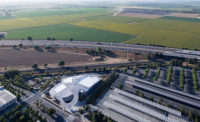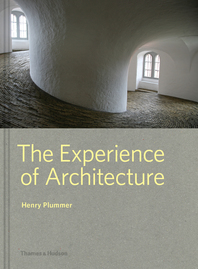In 1954, Ada Louise Huxtable mounted an exhibition for New York’s Museum of Modern Art called The Modern Movement in Italy: Architecture and Design. “Italy’s outstanding contribution in the field of reinforced-concrete engineering is shown through the work of Pier Luigi Nervi,” read a press release for the show. Nervi had yet to build the Palazetto dello Sport, an indoor arena for the 1960 Rome Olympics that was the world’s largest reinforced-concrete dome when completed (and whose span-to-thickness ratio of 2,400:1 is, figuratively speaking, eggshell thin). The image of its striking ribbed ceiling played out on television screens across the globe, making Nervi an international celebrity at age 70.
Aside from Huxtable, who would write a short book about Nervi in 1960, only a few investigations have documented his work in English—despite having, in his later years, completed notable structures in North America, including the 48-story Tour de la Bourse (1964) in Montreal with Luigi Moretti, which was the tallest reinforced-concrete tower in the world until 1968; St. Mary’s Cathedral (1971) in San Francisco, with Pietro Belluschi, which has a dramatic, tentlike concrete roof; and the Scope Arena (1971) in Norfolk, Virginia, which remains the world’s largest reinforced thin-shell concrete dome.
This new book by Thomas Leslie fills out the picture in a consistently engaging manner. Leslie, a professor of architecture at Iowa State University, tells the story of Nervi’s education and covers the full arc of his career, from his first partners to his collaborations with acclaimed architects in Italy (Gio Ponti on Milan’s Pirelli Tower) and abroad (Harry Seidler on Australia Square in Sydney, and Marcel Breuer on the UNESCO Secretariat in Paris) and to his own works as engineer, architect (and contractor). Leslie details the unremarkable early projects, Nervi’s grudging acceptance of Fascist architecture, and the blossoming of his career late in life, following the war and coinciding with Italy’s “economic miracle.” Most important for the reader, he also writes about complex structural elements with incredible ease and clarity while solidly establishing Nervi’s place in architectural history, which had faltered following his death in 1979. Notes Leslie, a younger generation (even, to an extent, Huxtable) “saw Nervi’s rigorous approach as part of ‘the Modernist straitjacket.’ ”
Though Nervi designed everything from skyscrapers to open-air stadiums and viaducts, he will forever be linked with concrete-shell buildings. While those structures saw their heyday in Nervi’s era, Postmodernism and economic forces led to a steep decline in their popularity. There has been a revival of sorts in recent years, according to structural engineer Guy Nordenson. He cites the work of Mutsuro Sasaki in Japan, who designed shells with Ryue Nishizawa for the bulbous Teshima Art Museum (2010), and Toyo Ito, for the swooping Meiso no Mori Funeral Hall (2006). The nearly 60-year-old International Association for Shell and Spatial Structures will hold its annual symposium at MIT this year July 16–20, with Eero Saarinen’s Kresge Auditorium shell structure serving as the principal venue. According to Leslie, “Nervi’s reputation is now enjoying a renaissance as his ideal of integrated engineering, construction, and design has resurfaced and performance and efficiency have taken on new importance.”







